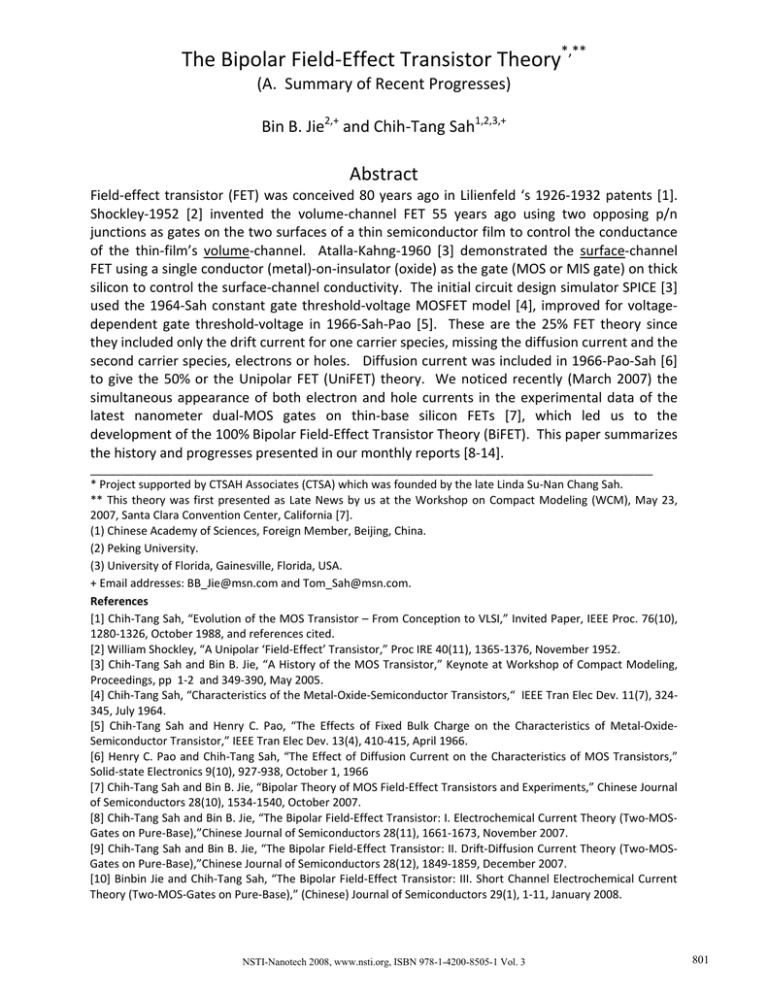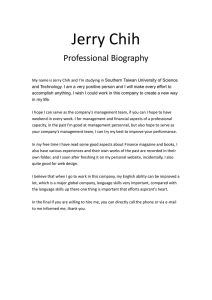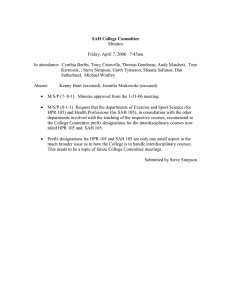The Bipolar Field-Effect Transistor Theory
advertisement

The Bipolar Field‐Effect Transistor Theory*,** (A. Summary of Recent Progresses) 2,+ Bin B. Jie and Chih‐Tang Sah1,2,3,+ Abstract Field‐effect transistor (FET) was conceived 80 years ago in Lilienfeld ‘s 1926‐1932 patents [1]. Shockley‐1952 [2] invented the volume‐channel FET 55 years ago using two opposing p/n junctions as gates on the two surfaces of a thin semiconductor film to control the conductance of the thin‐film’s volume‐channel. Atalla‐Kahng‐1960 [3] demonstrated the surface‐channel FET using a single conductor (metal)‐on‐insulator (oxide) as the gate (MOS or MIS gate) on thick silicon to control the surface‐channel conductivity. The initial circuit design simulator SPICE [3] used the 1964‐Sah constant gate threshold‐voltage MOSFET model [4], improved for voltage‐ dependent gate threshold‐voltage in 1966‐Sah‐Pao [5]. These are the 25% FET theory since they included only the drift current for one carrier species, missing the diffusion current and the second carrier species, electrons or holes. Diffusion current was included in 1966‐Pao‐Sah [6] to give the 50% or the Unipolar FET (UniFET) theory. We noticed recently (March 2007) the simultaneous appearance of both electron and hole currents in the experimental data of the latest nanometer dual‐MOS gates on thin‐base silicon FETs [7], which led us to the development of the 100% Bipolar Field‐Effect Transistor Theory (BiFET). This paper summarizes the history and progresses presented in our monthly reports [8‐14]. __________________________________________________________________________________________ * Project supported by CTSAH Associates (CTSA) which was founded by the late Linda Su‐Nan Chang Sah. ** This theory was first presented as Late News by us at the Workshop on Compact Modeling (WCM), May 23, 2007, Santa Clara Convention Center, California [7]. (1) Chinese Academy of Sciences, Foreign Member, Beijing, China. (2) Peking University. (3) University of Florida, Gainesville, Florida, USA. + Email addresses: BB_Jie@msn.com and Tom_Sah@msn.com. References [1] Chih‐Tang Sah, “Evolution of the MOS Transistor – From Conception to VLSI,” Invited Paper, IEEE Proc. 76(10), 1280‐1326, October 1988, and references cited. [2] William Shockley, “A Unipolar ‘Field‐Effect’ Transistor,” Proc IRE 40(11), 1365‐1376, November 1952. [3] Chih‐Tang Sah and Bin B. Jie, “A History of the MOS Transistor,” Keynote at Workshop of Compact Modeling, Proceedings, pp 1‐2 and 349‐390, May 2005. [4] Chih‐Tang Sah, “Characteristics of the Metal‐Oxide‐Semiconductor Transistors,“ IEEE Tran Elec Dev. 11(7), 324‐ 345, July 1964. [5] Chih‐Tang Sah and Henry C. Pao, “The Effects of Fixed Bulk Charge on the Characteristics of Metal‐Oxide‐ Semiconductor Transistor,” IEEE Tran Elec Dev. 13(4), 410‐415, April 1966. [6] Henry C. Pao and Chih‐Tang Sah, “The Effect of Diffusion Current on the Characteristics of MOS Transistors,” Solid‐state Electronics 9(10), 927‐938, October 1, 1966 [7] Chih‐Tang Sah and Bin B. Jie, “Bipolar Theory of MOS Field‐Effect Transistors and Experiments,” Chinese Journal of Semiconductors 28(10), 1534‐1540, October 2007. [8] Chih‐Tang Sah and Bin B. Jie, “The Bipolar Field‐Effect Transistor: I. Electrochemical Current Theory (Two‐MOS‐ Gates on Pure‐Base),”Chinese Journal of Semiconductors 28(11), 1661‐1673, November 2007. [9] Chih‐Tang Sah and Bin B. Jie, “The Bipolar Field‐Effect Transistor: II. Drift‐Diffusion Current Theory (Two‐MOS‐ Gates on Pure‐Base),”Chinese Journal of Semiconductors 28(12), 1849‐1859, December 2007. [10] Binbin Jie and Chih‐Tang Sah, “The Bipolar Field‐Effect Transistor: III. Short Channel Electrochemical Current Theory (Two‐MOS‐Gates on Pure‐Base),” (Chinese) Journal of Semiconductors 29(1), 1‐11, January 2008. NSTI-Nanotech 2008, www.nsti.org, ISBN 978-1-4200-8505-1 Vol. 3 801 [11] Binbin Jie and Chih‐Tang Sah, “The Bipolar Field‐Effect Transistor: IV. Short Channel Drift‐Diffusion Current Theory (Two‐MOS‐Gates on Pure‐Base),” (Chinese) Journal of Semiconductors 29(2), 193‐200, February 2008. [12] Chih‐Tang Sah and Binbin Jie, “The Theory of Field‐Effect Transistors: XI. The Bipolar Electrochemical Currents (1‐2‐MOS‐Gates on Thin‐Thick Pure‐Impure Base),” (Chinese) Journal of Semiconductors 29(3), 397‐409, March 2008. [13] Chih‐Tang Sah and Binbin Jie, “The Bipolar Theory of the Field‐Effect Transistors: X. The Fundamental Physics and Theory (All Devices Structures),” (Chinese) Journal of Semiconductors 29(4), 613‐619, April 2008. [14] Binbin Jie and Chih‐Tang Sah, “The Bipolar Field‐Effect Transistor: V. Bipolar Electrochemical Current Theory (Two‐MOS‐Gates on Pure‐Base),” (Chinese) Journal of Semiconductors 29(4), 620‐627, April 2008. 802 NSTI-Nanotech 2008, www.nsti.org, ISBN 978-1-4200-8505-1 Vol. 3


